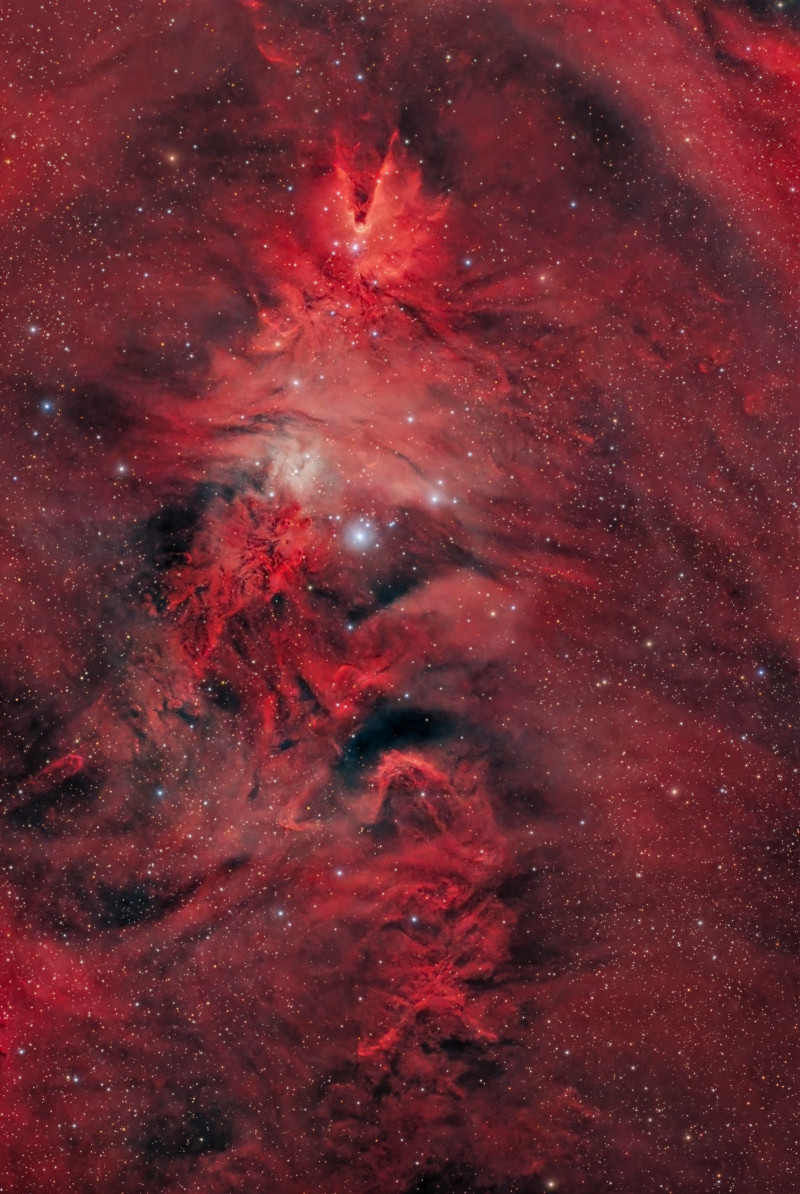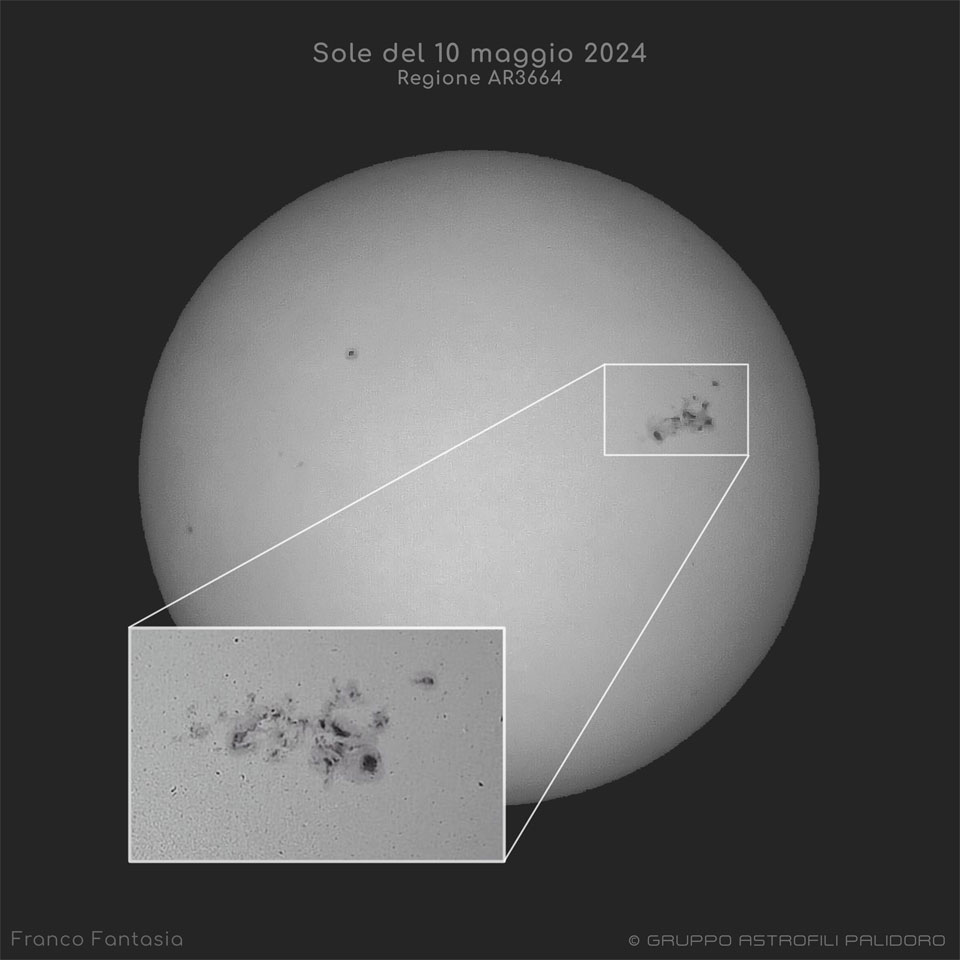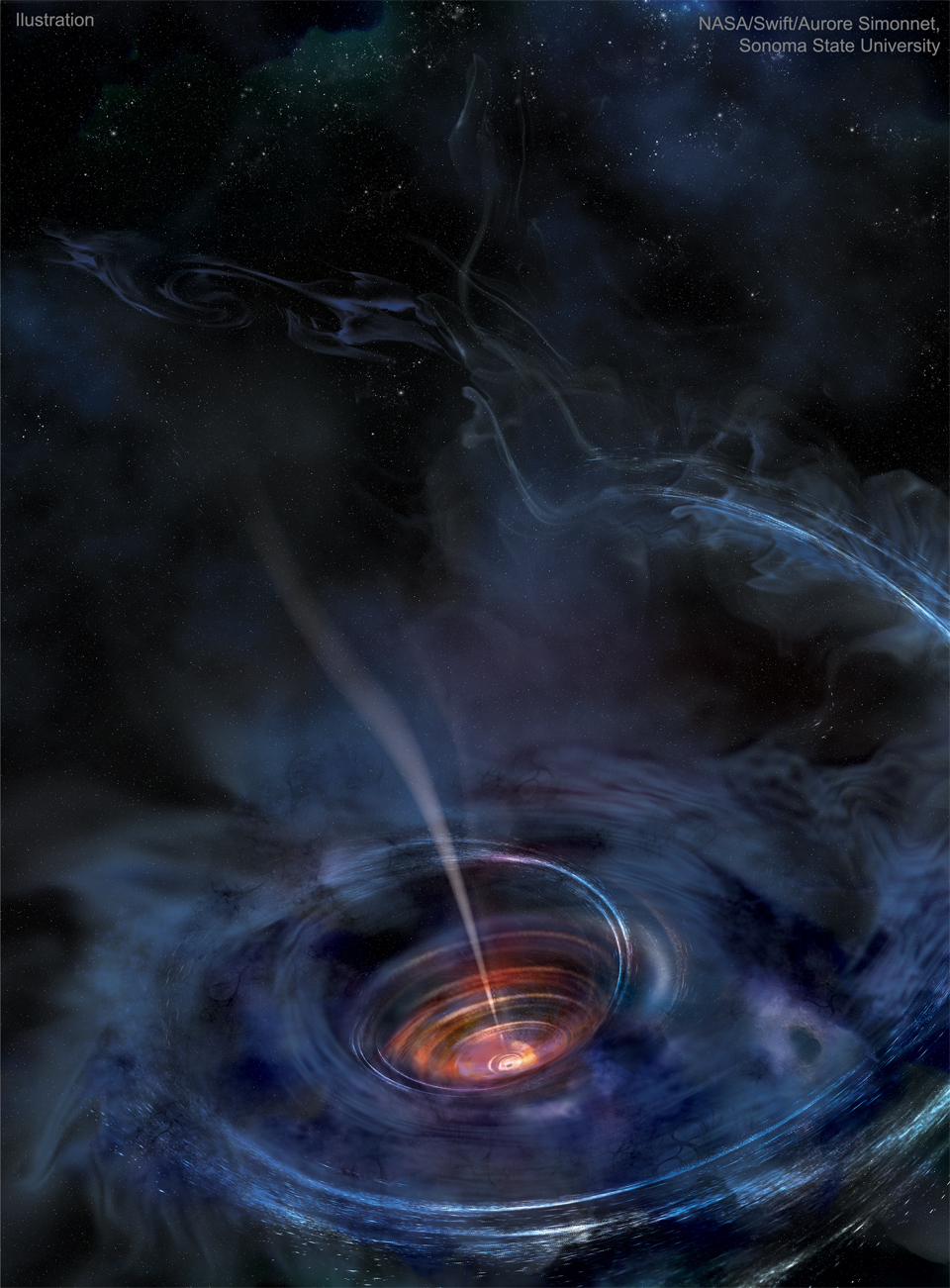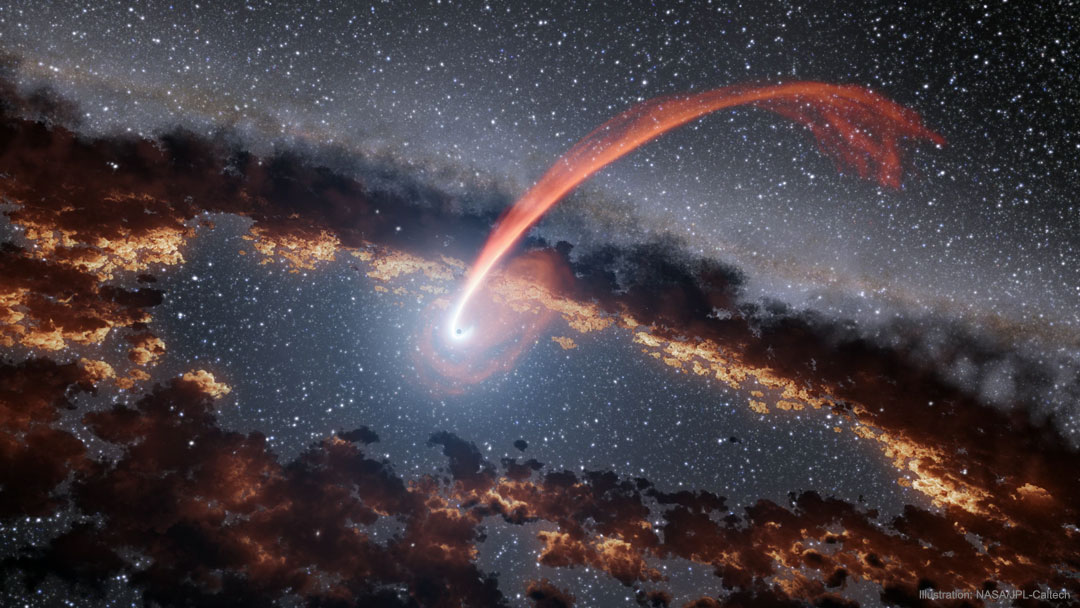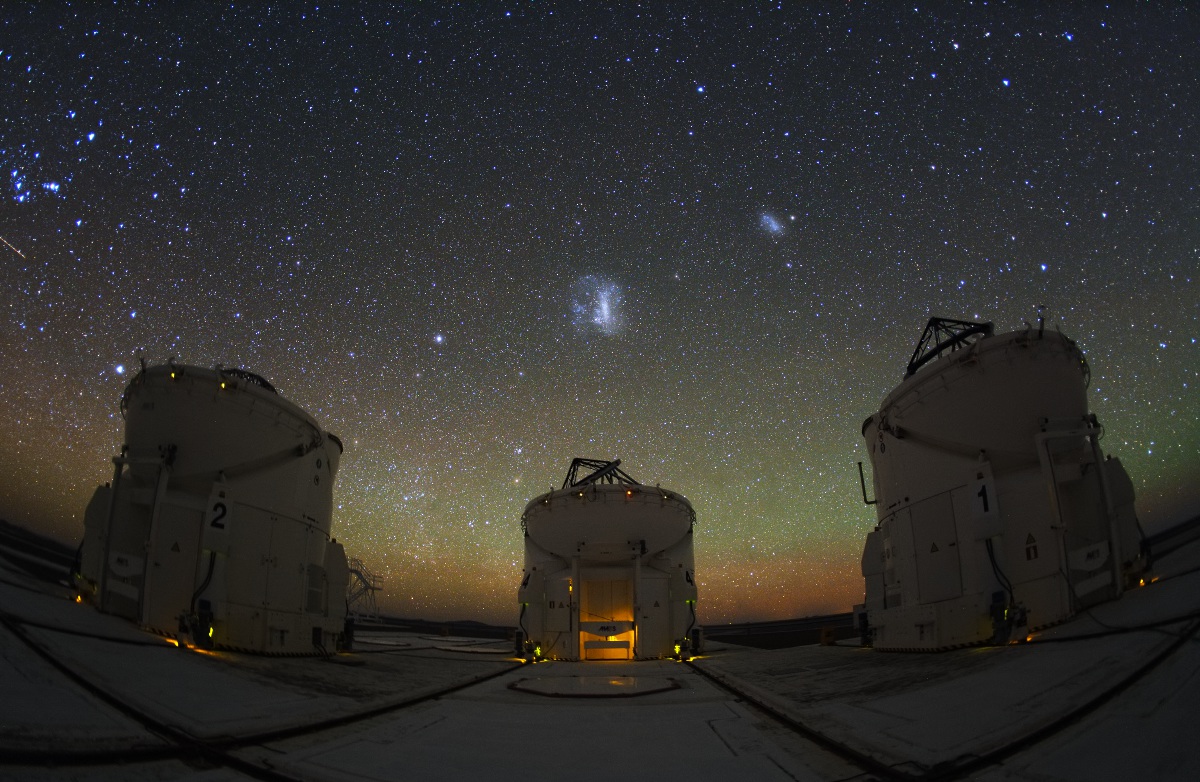Η Αστρονομική Εικόνα της Ημέρας από τη NASA
Unicorn, Fox Fur and Christmas Tree
25/12/2025
A star forming region cataloged as NGC 2264, this beautiful but complex arrangement of interstellar gas and dust is about 2,700 light-years distant in the faint but fanciful constellation Monoceros, the Unicorn. Seen toward the celestial equator and near the plane of our Milky Way galaxy, the seasonal skyscape mixes reddish emission nebulae excited by energetic light from newborn stars with dark interstellar dust clouds. Where the otherwise obscuring dust clouds lie close to the hot, young stars, they also reflect starlight, forming blue reflection nebulae. In fact, bright variable star S Monocerotis is immersed in a blue-tinted haze near center. Arrayed with a simple triangular outline above S Monocerotis, the stars of NGC 2264 are popularly known as the Christmas Tree star cluster. Carved by energetic starlight, the Cone Nebula sits upside down at the apex of this cosmic Christmas tree while the dusty, convoluted pelt of glowing gas and dust under the tree is called the Fox Fur Nebula. This rich telescopic frame spans about 1.5 degrees or 3 full moons on the sky top to bottom, covering nearly 80 light-years at the distance of NGC 2264.
Copyright: Michael Kalika
Προηγούμενες Αστρονομικές Εικόνες της Ημέρας από τη NASA
AR 3664: Giant Sunspot Group
11/05/2024
Right now, one of the largest sunspot groups in recent history is crossing the Sun. Active Region 3664 is not only big -- it's violent, throwing off clouds of particles into the Solar System. Some of these CMEs are already impacting the Earth, and others might follow. At the extreme, these solar storms could cause some Earth-orbiting satellites to malfunction, the Earth's atmosphere to slightly distort, and electrical power grids to surge. When impacting Earth's upper atmosphere, these particles can produce beautiful auroras, with some auroras already being reported unusually far south. Pictured here, AR3664 and its dark sunspots were captured yesterday in visible light from Rome, Italy. The AR3664 sunspot group is so large that it is visible just with glasses designed to view last month's total solar eclipse. This weekend, skygazing enthusiasts will be keenly watching the night skies all over the globe for bright and unusual auroras. Gallery: Active Region 3664 on the Sun and Associated Aurora
Copyright: Franco Fantasia & Guiseppe Conzo (Gruppo Astrofili Palidoro)
Simulation: Two Black Holes Merge
10/05/2024
Relax and watch two black holes merge. Inspired by the first direct detection of gravitational waves in 2015, this simulation plays in slow motion but would take about one third of a second if run in real time. Set on a cosmic stage, the black holes are posed in front of stars, gas, and dust. Their extreme gravity lenses the light from behind them into Einstein rings as they spiral closer and finally merge into one. The otherwise invisible gravitational waves generated as the massive objects rapidly coalesce cause the visible image to ripple and slosh both inside and outside the Einstein rings even after the black holes have merged. Dubbed GW150914, the gravitational waves detected by LIGO are consistent with the merger of 36 and 31 solar mass black holes at a distance of 1.3 billion light-years. The final, single black hole has 63 times the mass of the Sun, with the remaining 3 solar masses converted into energy radiated in gravitational waves. Today's Event Horizon: It's Black Hole Week at NASA!
Copyright: NASA
The Galaxy, the Jet, and a Famous Black Hole
09/05/2024
Bright elliptical galaxy Messier 87 (M87) is home to the supermassive black hole captured in 2017 by planet Earth's Event Horizon Telescope in the first ever image of a black hole. Giant of the Virgo galaxy cluster about 55 million light-years away, M87 is rendered in blue hues in this infrared image from the Spitzer Space telescope. Though M87 appears mostly featureless and cloud-like, the Spitzer image does record details of relativistic jets blasting from the galaxy's central region. Shown in the inset at top right, the jets themselves span thousands of light-years. The brighter jet seen on the right is approaching and close to our line of sight. Opposite, the shock created by the otherwise unseen receding jet lights up a fainter arc of material. Inset at bottom right, the historic black hole image is shown in context at the center of giant galaxy, between the relativistic jets. Completely unresolved in the Spitzer image, the supermassive black hole surrounded by infalling material is the source of enormous energy driving the relativistic jets from the center of active galaxy M87. The Event Horizon Telescope image of M87 has been enhanced to reveal a sharper view of the famous supermassive black hole. It's inescapable: Black Hole Week at NASA!
Copyright: NASA
Visualization: A Black Hole Accretion Disk
08/05/2024
What would it look like to circle a black hole? If the black hole was surrounded by a swirling disk of glowing and accreting gas, then the great gravity of the black hole would deflect light emitted by the disk to make it look very unusual. The featured animated video gives a visualization. The video starts with you, the observer, looking toward the black hole from just above the plane of the accretion disk. Surrounding the central black hole is a thin circular image of the orbiting disk that marks the position of the photon sphere -- inside of which lies the black hole's event horizon. Toward the left, parts of the large main image of the disk appear brighter as they move toward you. As the video continues, you loop over the black hole, soon looking down from the top, then passing through the disk plane on the far side, then returning to your original vantage point. The accretion disk does some interesting image inversions -- but never appears flat. Visualizations such as this are particularly relevant today as black holes are being imaged in unprecedented detail by the Event Horizon Telescope. Singularity Impressive: It's Black Hole Week at NASA!
Copyright: NASA
Black Hole Accreting with Jet
07/05/2024
What happens when a black hole devours a star? Many details remain unknown, but observations are providing new clues. In 2014, a powerful explosion was recorded by the ground-based robotic telescopes of the All Sky Automated Survey for SuperNovae (Project ASAS-SN), with followed-up observations by instruments including NASA's Earth-orbiting Swift satellite. Computer modeling of these emissions fit a star being ripped apart by a distant supermassive black hole. The results of such a collision are portrayed in the featured artistic illustration. The black hole itself is a depicted as a tiny black dot in the center. As matter falls toward the hole, it collides with other matter and heats up. Surrounding the black hole is an accretion disk of hot matter that used to be the star, with a jet emanating from the black hole's spin axis. Fall towards eternity: It's Black Hole Week at NASA!
Copyright: NASA
A Total Solar Eclipse from Sliver to Ring
06/05/2024
This is how the Sun disappeared from the daytime sky last month. The featured time-lapse video was created from stills taken from Mountain View, Arkansas, USA on 2024 April 8. First, a small sliver of a normally spotted Sun went strangely dark. Within a few minutes, much of the background Sun was hidden behind the advancing foreground Moon. Within an hour, the only rays from the Sun passing the Moon appeared like a diamond ring. During totality, most of the surrounding sky went dark, making the bright pink prominences around the Sun's edge stand out, and making the amazing corona appear to spread into the surrounding sky. The central view of the corona shows an accumulation of frames taken during complete totality. As the video ends, just a few minutes later, another diamond ring appeared -- this time on the other side of the Moon. Within the next hour, the sky returned to normal. Celebrate the Voids: It's Black Hole Week at NASA!
Copyright: Reinhold Wittich; Music: Sunrise from Also sprach Zarathusra (R. Strauss) by Sascha Ende
A Black Hole Disrupts a Passing Star
05/05/2024
What happens to a star that goes near a black hole? If the star directly impacts a massive black hole, then the star falls in completely -- and everything vanishes. More likely, though, the star goes close enough to have the black hole's gravity pull away its outer layers, or disrupt, the star. Then, most of the star's gas does not fall into the black hole. These stellar tidal disruption events can be as bright as a supernova, and an increasing amount of them are being discovered by automated sky surveys. In the featured artist's illustration, a star has just passed a massive black hole and sheds gas that continues to orbit. The inner edge of a disk of gas and dust surrounding the black hole is heated by the disruption event and may glow long after the star is gone. Hole New Worlds: It's Black Hole Week at NASA!
Copyright: NASA
3 ATs
04/05/2024
Despite their resemblance to R2D2, these three are not the droids you're looking for. Instead, the enclosures house 1.8 meter Auxiliary Telescopes (ATs) at Paranal Observatory in the Atacama Desert region of Chile. The ATs are designed to be used for interferometry, a technique for achieving extremely high resolution observations, in concert with the observatory's 8 meter Very Large Telescope units. A total of four ATs are operational, each fitted with a transporter that moves the telescope along a track allowing different arrays with the large unit telescopes. To work as an interferometer, the light from each telescope is brought to a common focal point by a system of mirrors in underground tunnels. Above these three ATs, the Large and Small Magellanic Clouds are the far, far away satellite galaxies of our own Milky Way. In the clear and otherwise dark southern skies, planet Earth's greenish atmospheric airglow stretches faintly along the horizon.
Copyright: Yuri Beletsky
Η Αστρονομική Εικόνα της Ημέρας από τη NASA (NASA Astronomy Picture of the Day) είναι μια δωρεάν υπηρεσία που παρέχει καθημερινά μια εντυπωσιακή εικόνα από το σύμπαν, την λήψη της οποίας έχει πραγματοποιήσει κάποιος από τους αστρονόμους της NASA ή από κάποιον από τους δορυφόρους ή τα τηλεσκόπια που η NASA λειτουργεί. Οι εικόνες που εμφανίζονται καλύπτουν μια ευρεία γκάμα από θέματα, συμπεριλαμβανομένων των αστερισμών, των γαλαξιών, των πλανητικών συστημάτων, των κομητών, των αστρικών σωμάτων και των παρατηρητηρίων. Κάθε εικόνα συνοδεύεται από μια σύντομη εξήγηση και πληροφορίες σχετικά με το τι παρατηρείται στην εικόνα.
